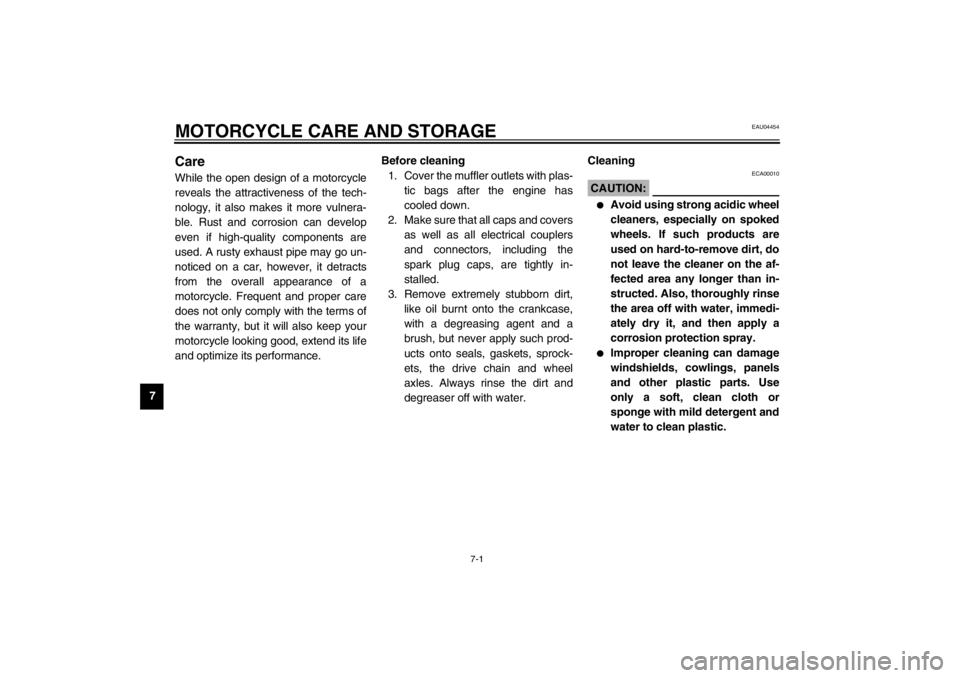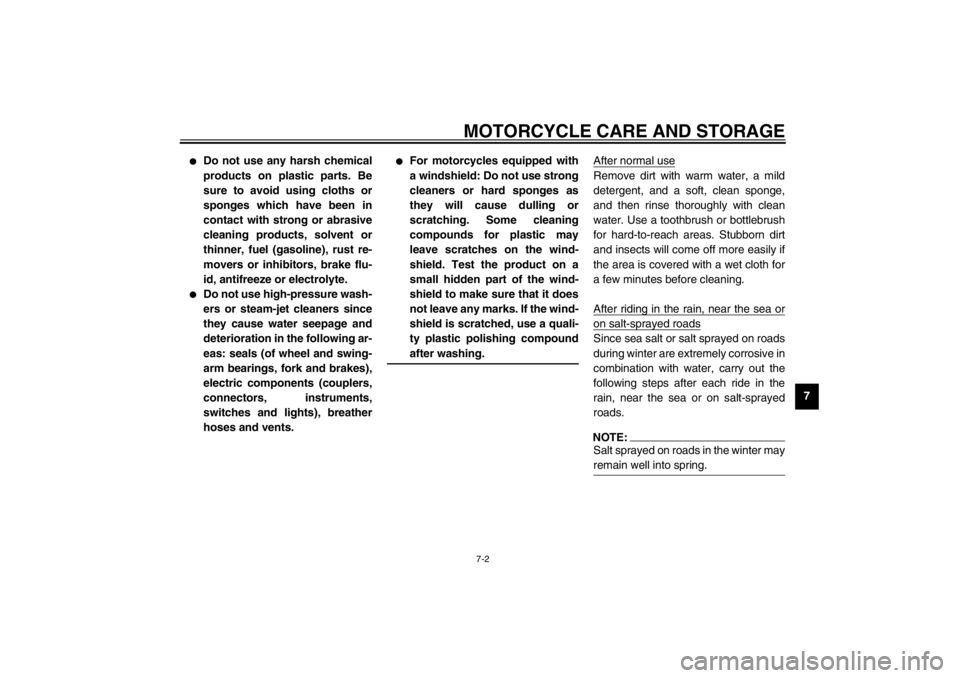Page 77 of 110
PERIODIC MAINTENANCE AND MINOR REPAIR
6-32
6 2. Hold the lower ends of the front
fork legs and try to move them for-
ward and backward. If any free
play can be felt, have a Yamaha
dealer check or repair the steer-
ing.
EAU01144
Checking the wheel bearings The front and rear wheel bearings must
be checked at the intervals specified in
the periodic maintenance and lubrica-
tion chart. If there is play in the wheel
hub or if the wheel does not turn
smoothly, have a Yamaha dealer
check the wheel bearings.
U5PSE0.book Page 32 Thursday, December 13, 2001 4:29 PM
Page 82 of 110

PERIODIC MAINTENANCE AND MINOR REPAIR
6-37
6
EAU03497
Replacing a turn signal light
bulb 1. Remove the turn signal light lens
by removing the screw.
2. Remove the defective bulb by
pushing it in and turning it counter-
clockwise.3. Insert a new bulb into the socket,
push it in, and then turn it clock-
wise until it stops.
4. Install the lens by installing the
screw.
ECA00065
CAUTION:@ Do not overtighten the screw, other-
wise the lens may break. @
EAU01579
Supporting the motorcycle Since this model is not equipped with a
centerstand, follow these precautions
when removing the front and rear
wheel or performing other mainte-
nance requiring the motorcycle to
stand upright. Check that the motor-
cycle is in a stable and level position
before starting any maintenance. A
strong wooden box can be placed un-
der the engine for added stability.
To service the front wheel
1. Stabilize the rear of the motorcycle
by using a motorcycle stand or, if
an additional motorcycle stand is
not available, by placing a jack un-
der the frame in front of the rear
wheel.
2. Raise the front wheel off the
ground by using a motorcycle
stand.
1. Screw
2. Turn signal light lens
1. Turn signal light bulb
U5PSE0.book Page 37 Thursday, December 13, 2001 4:29 PM
Page 83 of 110

PERIODIC MAINTENANCE AND MINOR REPAIR
6-38
6 To service the rear wheel
Raise the rear wheel off the ground by
using a motorcycle stand or, if a motor-
cycle stand is not available, by placing
a jack either under each side of the
frame in front of the rear wheel or under
each side of the swingarm.
EAU01617
Front wheel To remove the front wheel
EW000122
WARNING
_ �
It is advisable to have a Yamaha
dealer service the wheel.
�
Securely support the motor-
cycle so that there is no danger
of it falling over.
_1. Loosen the front wheel axle pinch
bolt, then the brake caliper bolts.
2. Loosen the wheel axle with a 19-mm
hexagon wrench.3. Lift the front wheel off the ground
according to the procedure on
page 6-37.
4. Remove the brake hose holders
by removing the bolts.
5. Remove the brake calipers by re-
moving the bolts.
6. Pull the wheel axle out, and then
remove the wheel.
ECA00046
CAUTION:_ Do not apply the brake after the
brake calipers have been removed,
otherwise the brake pads will be
forced shut. _
1. Wheel axle
2. Front wheel axle pinch bolt
1. Bolt (× 2)
2. Brake caliper
U5PSE0.book Page 38 Thursday, December 13, 2001 4:29 PM
Page 84 of 110

PERIODIC MAINTENANCE AND MINOR REPAIR
6-39
6
EAU04376
To install the front wheel
1. Lift the wheel up between the fork
legs.
2. Insert the wheel axle.
3. Lower the front wheel so that it is
on the ground.
4. Install the brake calipers by install-
ing the bolts.NOTE:_ Make sure that there is enough space
between the brake pads before install-
ing the brake calipers onto the brake
discs. _5. Install the brake hose holders by
installing the bolts.
6. Tighten the wheel axle, the front
wheel axle pinch bolt and the
brake caliper bolts to the specified
torques.7. Push down hard on the handlebar
several times to check for proper
fork operation.
EAU04455
Rear wheel To remove the rear wheel
EW000122
WARNING
_ �
It is advisable to have a Yamaha
dealer service the wheel.
�
Securely support the motor-
cycle so that there is no danger
of it falling over.
_
Tightening torques:
Wheel axle:
72 Nm (7.2 m·kgf)
Front wheel axle pinch bolt:
20 Nm (2.0 m·kgf)
Brake caliper bolt:
40 Nm (4.0 m·kgf)
1. Bolt (× 2)
2. Quick fastener (× 3)
U5PSE0.book Page 39 Thursday, December 13, 2001 4:29 PM
Page 85 of 110
PERIODIC MAINTENANCE AND MINOR REPAIR
6-40
6 1. Remove the drive chain cover by
removing the quick fasteners and
the bolts.2. Loosen the axle nut and the brake
caliper bracket bolt.
3. Lift the rear wheel off the ground
according to the procedure on
page 6-39.4. Remove the axle nut.
5. Loosen the locknut on each side of
the swingarm.
6. Turn the drive chain slack adjust-
ing bolts fully in direction
a.
7. Push the wheel forward, tighten
the caliper bracket bolt and then
remove the drive chain from the
rear sprocket.
NOTE:_ The drive chain does not need to be
disassembled in order to remove and
install the rear wheel. _
1. Quick fastener
2. Pin
After removal
Before installation
1. Axle nut
2. Drive chain slack adjusting bolt
3. Locknut
4. Alignment marks
1. Bolt
2. Brake caliper bracket
U5PSE0.book Page 40 Thursday, December 13, 2001 4:29 PM
Page 86 of 110

PERIODIC MAINTENANCE AND MINOR REPAIR
6-41
68. Pull the wheel axle out, and then
remove the wheel.
ECA00119
CAUTION:_ Do not apply the brake after the
wheel has been removed together
with the brake disc, otherwise the
brake caliper pistons will be forced
out. _
EAU04456
To install the rear wheel
1. Install the wheel by inserting the
wheel axle from the right hand
side.NOTE:_ Make sure that there is enough space
between the brake pads before install-
ing the wheel. _2. Install the drive chain onto the rear
sprocket.
3. Loosen the brake caliper bracket
bolt.
4. Adjust the drive chain slack. (See
page 6-27 for drive chain slack ad-
justment procedures.)
5. Install the axle nut, and then lower
the rear wheel so that it is on the
ground.
6. Tighten the axle nut and the brake
caliper bracket bolt to the specified
torques.7. Install the drive chain cover by in-
stalling the bolts and quick fasten-
ers.
NOTE:_ To install a quick fastener, push the pin
back so that it will protrude from the
fastener head, and then insert the fas-
tener and push the protruding pin in un-
til it is flush with the fastener head. _
Tightening torques:
Axle nut:
150 Nm (15.0 m·kgf)
Brake caliper bracket bolt:
40 Nm (4.0 m·kgf)
U5PSE0.book Page 41 Thursday, December 13, 2001 4:29 PM
Page 92 of 110

7-1
7
EAU04454
7-MOTORCYCLE CARE AND STORAGECare While the open design of a motorcycle
reveals the attractiveness of the tech-
nology, it also makes it more vulnera-
ble. Rust and corrosion can develop
even if high-quality components are
used. A rusty exhaust pipe may go un-
noticed on a car, however, it detracts
from the overall appearance of a
motorcycle. Frequent and proper care
does not only comply with the terms of
the warranty, but it will also keep your
motorcycle looking good, extend its life
and optimize its performance.Before cleaning
1. Cover the muffler outlets with plas-
tic bags after the engine has
cooled down.
2. Make sure that all caps and covers
as well as all electrical couplers
and connectors, including the
spark plug caps, are tightly in-
stalled.
3. Remove extremely stubborn dirt,
like oil burnt onto the crankcase,
with a degreasing agent and a
brush, but never apply such prod-
ucts onto seals, gaskets, sprock-
ets, the drive chain and wheel
axles. Always rinse the dirt and
degreaser off with water.Cleaning
ECA00010
CAUTION:_ �
Avoid using strong acidic wheel
cleaners, especially on spoked
wheels. If such products are
used on hard-to-remove dirt, do
not leave the cleaner on the af-
fected area any longer than in-
structed. Also, thoroughly rinse
the area off with water, immedi-
ately dry it, and then apply a
corrosion protection spray.
�
Improper cleaning can damage
windshields, cowlings, panels
and other plastic parts. Use
only a soft, clean cloth or
sponge with mild detergent and
water to clean plastic.
U5PSE0.book Page 1 Thursday, December 13, 2001 4:29 PM
Page 93 of 110

MOTORCYCLE CARE AND STORAGE
7-2
7
�
Do not use any harsh chemical
products on plastic parts. Be
sure to avoid using cloths or
sponges which have been in
contact with strong or abrasive
cleaning products, solvent or
thinner, fuel (gasoline), rust re-
movers or inhibitors, brake flu-
id, antifreeze or electrolyte.
�
Do not use high-pressure wash-
ers or steam-jet cleaners since
they cause water seepage and
deterioration in the following ar-
eas: seals (of wheel and swing-
arm bearings, fork and brakes),
electric components (couplers,
connectors, instruments,
switches and lights), breather
hoses and vents.
�
For motorcycles equipped with
a windshield: Do not use strong
cleaners or hard sponges as
they will cause dulling or
scratching. Some cleaning
compounds for plastic may
leave scratches on the wind-
shield. Test the product on a
small hidden part of the wind-
shield to make sure that it does
not leave any marks. If the wind-
shield is scratched, use a quali-
ty plastic polishing compound
after washing.
_
After normal useRemove dirt with warm water, a mild
detergent, and a soft, clean sponge,
and then rinse thoroughly with clean
water. Use a toothbrush or bottlebrush
for hard-to-reach areas. Stubborn dirt
and insects will come off more easily if
the area is covered with a wet cloth for
a few minutes before cleaning.
After riding in the rain, near the sea oron salt-sprayed roadsSince sea salt or salt sprayed on roads
during winter are extremely corrosive in
combination with water, carry out the
following steps after each ride in the
rain, near the sea or on salt-sprayed
roads.NOTE:_ Salt sprayed on roads in the winter may
remain well into spring. _
U5PSE0.book Page 2 Thursday, December 13, 2001 4:29 PM